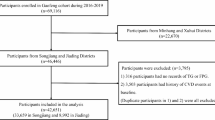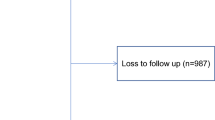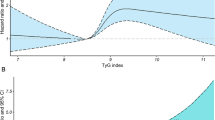Abstract
Purpose
Previous studies suggest that triglyceride-glucose index (TyG) index, as a marker of insulin resistance, may have associations with the risk of cardiovascular diseases (CVD) in elderly population. Given the paucity of data, it remains controversial, especially in general Chinese population. We aimed to further assess whether TyG index is an independent risk factor for CVD.
Methods
We conducted a prospective cohort study that enrolled a total of 96,541 participants from the Kailuan Study. TyG index was calculated as ln (fasting triglyceride [mg/dL] × fasting glucose [mg/dL]/2). Participants were divided into four groups (Q1, Q2, Q3, and Q4) by quartiles of the TyG index. Any CVD events occurred during 2006–2017 were recorded, including myocardial infarction (MI) and stroke. We assessed the association of TyG index with the risk of CVD and the subtypes of CVD by using Cox models estimated hazard ratios (HRs) and 95% confidence interval (CIs).
Results
During a median follow-up of 10.33 years, totally 6421 CVD events, 1493 MIs, and 5083 stroke events occurred. Multivariate Cox regression analysis showed that compared with Q1, HR (95% CI) for CVD events was 1.12 (95%, 1.03–1.21) in Q2, 1.28 (95%, 1.18–1.38) in Q3, and 1.34 (95%, 1.23–1.45) in Q4. In a time-dependent Cox Model we also found that compared with Q1, HR (95% CI) for CVD events was 1.09 (95%, 1.02–1.18) in Q2, 1.18 (95%, 1.09–1.27) in Q3, and 1.20 (95%, 1.11–1.30) in Q4. Similar results were showed in MI and stroke.
Conclusions
TyG index as a marker of insulin resistance was an independent risk factor for CVD. This may help in the early identification of people at high risk of CVD and be applicable to the primordial and primary prevention.

Similar content being viewed by others
Data availability
De-identified data are available to researchers upon request by contacting with the corresponding author.
References
GBD 2017 Causes of Death Collaborators. Global, regional, and national age-sex-specific mortality for 282 causes of death in 195 countries and territories, 1980-2017: a systematic analysis for the Global Burden of Disease Study 2017. Lancet 392(10159), 1736–1788 (2018). https://doi.org/10.1016/S0140-6736(18)32203-7
C. Han, F. Liu, X. Yang et al. Ideal cardiovascular health and incidence of atherosclerotic cardiovascular disease among Chinese adults: the China-PAR project. Sci. China Life Sci. 61(5), 504–514 (2018). https://doi.org/10.1007/s11427-018-9281-6
V. Ormazabal, S. Nair, O. Elfeky, C. Aguayo, C. Salomon, F.A. Zuñiga, Association between insulin resistance and the development of cardiovascular disease. Cardiovasc Diabetol. 17(1), 122 (2018). https://doi.org/10.1186/s12933-018-0762-4
R. Scicali, P. Giral, L. D’Erasmo et al. High TG to HDL ratio plays a significant role on atherosclerosis extension in prediabetes and newly diagnosed type 2 diabetes subjects. Diabetes Metab. Res Rev. 37(2), e3367 (2021). https://doi.org/10.1002/dmrr.3367
B.J. Arsenault, J.S. Rana, E.S. Stroes et al. Beyond low-density lipoprotein cholesterol: respective contributions of non-high-density lipoprotein cholesterol levels, triglycerides, and the total cholesterol/high-density lipoprotein cholesterol ratio to coronary heart disease risk in apparently healthy men and women. J. Am. Coll. Cardiol. 55(1), 35–41 (2009). https://doi.org/10.1016/j.jacc.2009.07.057
A. Varbo, M. Benn, A. Tybjærg-Hansen, A.B. Jørgensen, R. Frikke-Schmidt, B.G. Nordestgaard, Remnant cholesterol as a causal risk factor for ischemic heart disease. J. Am. Coll. Cardiol. 61(4), 427–436 (2013). https://doi.org/10.1016/j.jacc.2012.08.1026
M. Zhang, B. Wang, Y. Liu et al. Cumulative increased risk of incident type 2 diabetes mellitus with increasing triglyceride glucose index in normal-weight people: The Rural Chinese Cohort Study. Cardiovasc Diabetol. 16(1), 30 (2017). https://doi.org/10.1186/s12933-017-0514-x
W.Y. Su, S.C. Chen, Y.T. Huang et al. Comparison of the effects of fasting glucose, hemoglobin A1c, and triglyceride-glucose index on cardiovascular events in Type 2 diabetes mellitus. Nutrients 11(11), 2838 (2019). https://doi.org/10.3390/nu11112838
A. Sánchez-García, R. Rodríguez-Gutiérrez, L. Mancillas-Adame et al. Diagnostic accuracy of the triglyceride and glucose index for insulin resistance: a systematic review. Int J. Endocrinol. 2020, 4678526 (2020). https://doi.org/10.1155/2020/4678526
S.B. Lee, C.W. Ahn, B.K. Lee et al. Association between triglyceride glucose index and arterial stiffness in Korean adults. Cardiovasc. Diabetol. 17(1), 41 (2018). https://doi.org/10.1186/s12933-018-0692-1
S. Zhao, S. Yu, C. Chi et al. Association between macro- and microvascular damage and the triglyceride glucose index in community-dwelling elderly individuals: the Northern Shanghai Study. Cardiovasc. Diabetol. 18(1), 95 (2019). https://doi.org/10.1186/s12933-019-0898-x
C. Irace, C. Carallo, F.B. Scavelli et al. Markers of insulin resistance and carotid atherosclerosis. A comparison of the homeostasis model assessment and triglyceride glucose index. Int J. Clin. Pract. 67(7), 665–72 (2013). https://doi.org/10.1111/ijcp.12124
L. Sánchez-Íñigo, D. Navarro-González, A. Fernández-Montero, J. Pastrana-Delgado, J.A. Martínez, The TyG index may predict the development of cardiovascular events. Eur. J. Clin. Investig. 46(2), 189–97 (2016). https://doi.org/10.1111/eci.12583
X. Ma, H. Cui, M. Sun et al. Fasting blood glucose, cholesterol, and risk of primary liver cancer: the kailuan study. Cancer Res. Treat. (2021). https://doi.org/10.4143/crt.2020.817
M. Sun, W. Wang, X. Liu et al. Total cholesterol, alanine aminotransferase and the risk of primary liver cancer: a population-based prospective study. Medicine 100(18), e25746 (2021). https://doi.org/10.1097/MD.0000000000025746
X. Ma, L. Dong, Q. Shao et al. Triglyceride glucose index for predicting cardiovascular outcomes after percutaneous coronary intervention in patients with type 2 diabetes mellitus and acute coronary syndrome. Cardiovasc. Diabetol. 19(1), 31 (2020). https://doi.org/10.1186/s12933-020-01006-7
Stroke-1989, Recommendations on stroke prevention, diagnosis, and therapy. Report of the WHO task force on stroke and other cerebrovascular disorders. Stroke 20(10), 1407–31 (1989). https://doi.org/10.1161/01.str.20.10.1407
K. Thygesen, J.S. Alpert, A.S. Jaffe et al. Fourth universal definition of myocardial infarction (2018). J. Am. Coll. Cardiol. 72(18), 2231–2264 (2018). https://doi.org/10.1016/j.jacc.2018.08.1038
S. Wu, S. An, W. Li et al. Association of trajectory of cardiovascular health score and incident cardiovascular disease. JAMA Netw. Open 2(5), e194758 (2019). https://doi.org/10.1001/jamanetworkopen.2019.4758
L. Desquilbet, F. Mariotti, Dose-response analyses using restricted cubic spline functions in public health research. Stat. Med. 29(9), 1037–57 (2010). https://doi.org/10.1002/sim.3841
B. Lau, S.R. Cole, S.J. Gange, Competing risk regression models for epidemiologic data. Am. J. Epidemiol. 170(2), 244–56 (2009). https://doi.org/10.1093/aje/kwp107
S.D. Berry, L. Ngo, E.J. Samelson, D.P. Kiel, Competing risk of death: an important consideration in studies of older adults. J. Am. Geriatr. Soc. 58(4), 783–7 (2010). https://doi.org/10.1111/j.1532-5415.2010.02767.x
S. Wu, Y. Song, S. Chen et al. Blood pressure classification of 2017 associated with cardiovascular disease and mortality in young Chinese adults. Hypertension 76(1), 251–258 (2020). https://doi.org/10.1161/HYPERTENSIONAHA.119.14239
S. Li, B. Guo, H. Chen et al. The role of the triglyceride (triacylglycerol) glucose index in the development of cardiovascular events: a retrospective cohort analysis. Sci. Rep. 9(1), 7320 (2019). https://doi.org/10.1038/s41598-019-43776-5
M. Zhao, L. Song, L. Sun et al. Associations of Type 2 diabetes onset age with cardiovascular disease and mortality: the Kailuan study. Diabetes Care. 44(6), 1426–32 (2021). https://doi.org/10.2337/DC20-2375
A. Janus, E. Szahidewicz-Krupska, G. Mazur, A. Doroszko, Insulin resistance and endothelial dysfunction constitute a common therapeutic target in cardiometabolic disorders. Mediators Inflamm. 2016, 3634948 (2016). https://doi.org/10.1155/2016/3634948
M. Montagnani, I. Golovchenko, I. Kim et al. Inhibition of phosphatidylinositol 3-kinase enhances mitogenic actions of insulin in endothelial cells. J. Biol. Chem. 277(3), 1794–9 (2002). https://doi.org/10.1074/jbc.M103728200
J.A. Kim, M. Montagnani, K.K. Koh, M.J. Quon, Reciprocal relationships between insulin resistance and endothelial dysfunction: molecular and pathophysiological mechanisms. Circulation 113(15), 1888–904 (2006). https://doi.org/10.1161/CIRCULATIONAHA.105.563213
Y.T. Zhou, P. Grayburn, A. Karim et al. Lipotoxic heart disease in obese rats: implications for human obesity. Proc. Natl Acad. Sci. USA. 97(4), 1784–9 (2000). https://doi.org/10.1073/pnas.97.4.1784
Acknowledgements
The authors thank all the members of the Kailuan Study Team for their contribution and the participants who contribution their data. All authors revised and approved the article as submitted.
Author information
Authors and Affiliations
Corresponding author
Ethics declarations
Conflict of interest
The authors declare no competing interests.
Ethics approval
This study followed the Declaration of Helsinki and was approved by the Ethics Committee of the Kailuan Medical Group.
Consent to participate
All participants signed an informed consent.
Additional information
Publisher’s note Springer Nature remains neutral with regard to jurisdictional claims in published maps and institutional affiliations.
Supplementary information
Rights and permissions
About this article
Cite this article
Liu, Q., Cui, H., Ma, Y. et al. Triglyceride-glucose index associated with the risk of cardiovascular disease: the Kailuan study. Endocrine 75, 392–399 (2022). https://doi.org/10.1007/s12020-021-02862-3
Received:
Accepted:
Published:
Issue Date:
DOI: https://doi.org/10.1007/s12020-021-02862-3




